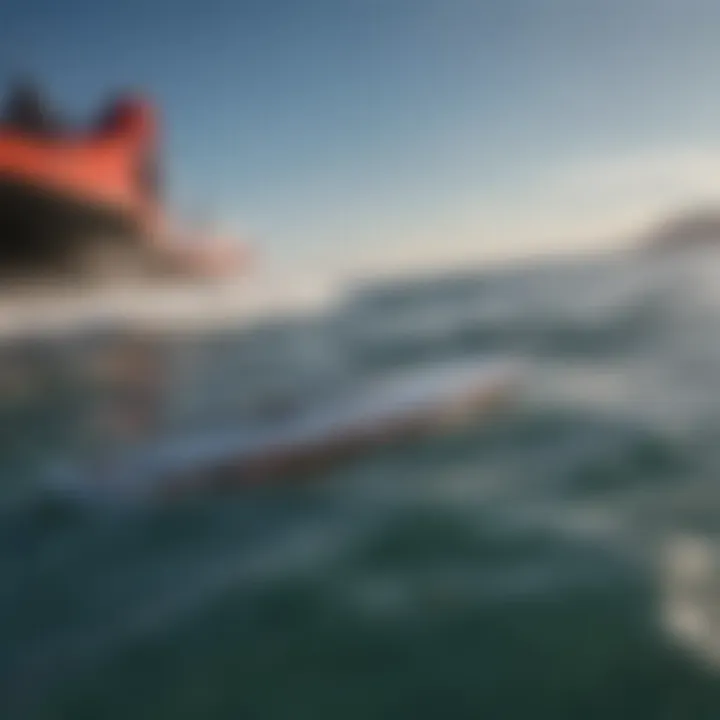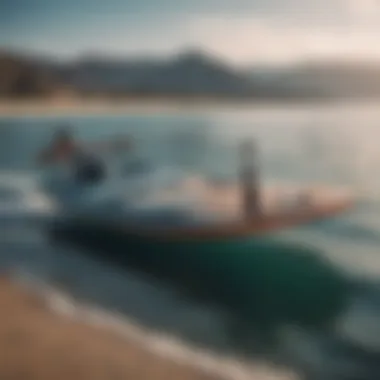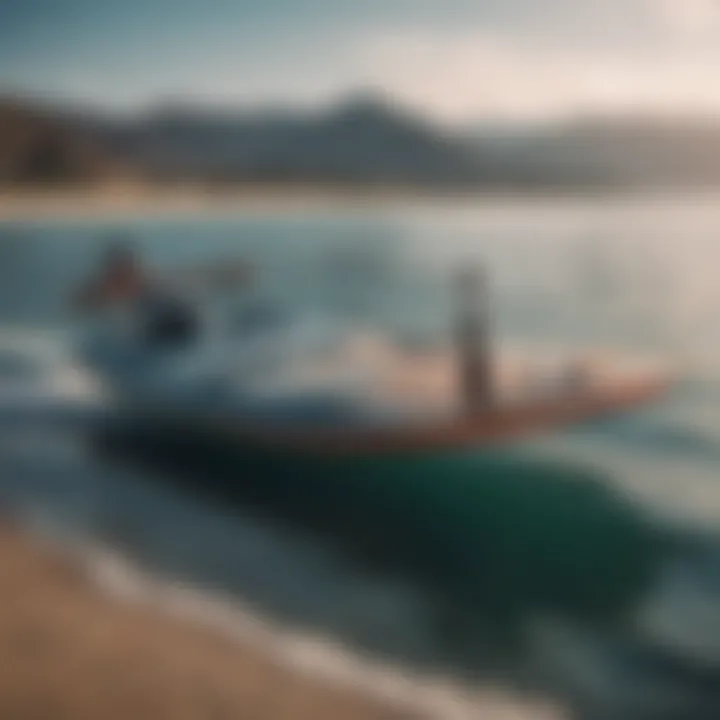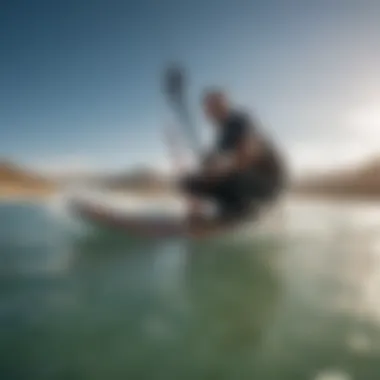Understanding Hydrofoil Board Costs for Kitesurfers


Intro
When it comes to kitesurfing, many enthusiasts find themselves riding the waves of excitement, but there's more beneath the surface than just the thrill of the sport. One critical aspect that often goes overlooked is the cost associated with hydrofoil boards. Understanding what shapes those costs can help you make smarter choices, whether you're a seasoned kiteboarder or a newbie just getting started.
The world of hydrofoil boards can be a tangled web of specifications and pricing structures. Factors like materials, design intricacies, and brand reputation all contribute to the monetary value you see. If you've ever scratched your head over the price disparities between one model and another, you’re not alone.
In this article, we're aiming to peel back the layers and dive deep into the ins and outs of hydrofoil board expenses. You’ll get insights on what features matter, how you can anticipate a return on your investment, and even how these boards stack up against the traditional alternatives. With rising interest in kitesurfing globally, staying abreast of market trends becomes all the more vital.
Let's embark on this journey, other kitesurfers are being mindful of their choices as they navigate through the endless options laid out before them. The objective here is to make sense of all this so you can steer clear of costly mistakes and make informed purchases alongside others who share your passion.
The Basics of Hydrofoil Boarding
Understanding hydrofoil boarding is fundamental for anyone looking to dive into the world of kitesurfing and kiteboarding. This emerging sport offers a unique way to experience riding above the water, and it's essential to grasp how hydrofoils function and the advantages they present compared to traditional boards.
Foreword to Hydrofoils
Hydrofoils have rapidly become a staple in the watersport community. At first glance, a hydrofoil board may look quite distinct from a typical surfboard or kiteboard. These boards are equipped with a submerged wing system that lifts the rider above the water, significantly reducing drag. This innovation not only enhances speed but allows for a smoother ride on choppy waters. The thrill of gliding above the waves is an experience that many riders chase.
When considering hydrofoil boards, it's crucial to realize that their design isn't just for aesthetics. One of the major benefits of using a hydrofoil is the ability to ride in lighter winds. This makes them attractive for surfers in varying conditions, particularly in spots where wind speeds fluctuate. For adventurers who enjoy exploring nature on the water, hydrofoils expand the range of environments that can be tackled. With these boards, riders can take on conditions that might leave conventional boards struggling.
How Hydrofoil Boards Work
To grasp the mechanics behind hydrofoils, one must understand the principles of lift and drag. When a rider pushes off on a hydrofoil, the board moves through the water, and as it gains speed, the hydrofoil wing below the surface generates lift. This lift counters the weight of the rider, raising the board and the rider above the surface.
The unique shape of the hydrofoil, designed similarly to airplane wings, allows it to manipulate water flow effectively. The result? Less surface contact means less drag. Consequently, riders can attain impressive speeds even with minimal wind. Adjusting the angle of the foil can also control lift, meaning a rider can fine-tune their experience based on their skill level and the conditions they face.
Hydrofoiling can sound technical and a bit intimidating for newcomers, yet understanding these basic concepts is vital for making informed decisions around purchasing and using these boards. With the right knowledge, riders can harness the full potential of hydrofoil boarding and enjoy the exhilarating rides it offers.
In summary, this section offers insight into what hydrofoil boarding entails — from its innovative designs to how these boards change the dynamics of kitesurfing. As we continue through this guide, we will explore the various costs associated with purchasing hydrofoils, ensuring that prospective buyers can navigate their options with clarity and confidence.
Cost Components of Hydrofoil Boards
Understanding the cost components of hydrofoil boards is essential for buyers looking to make informed decisions. Not only do these factors affect the price, but they can also have long-term implications regarding performance, durability, and overall satisfaction with the product. When considering a hydrofoil board, various elements come into play: material quality, brand reputation, design variations, and included accessories. This section dives into these components, unpacking what they entail, and how they contribute to the final price of a hydrofoil board.
Material Quality and Construction
The materials used in crafting hydrofoil boards can’t be overstated. They play a crucial role not just in the cost, but also in the board’s performance and longevity. High-quality materials, such as carbon fiber or aerospace-grade aluminum, can significantly boost a board’s strength while keeping it light. On the other hand, boards made from cheaper materials like plastic may be easier on the wallet, but they often lack the rigidity and responsiveness that the more serious riders expect.
Moreover, construction techniques vary from manufacturers. Boards that undergo advanced construction methods, such as vacuum bagging or infusion processes, are generally more robust and can endure tougher conditions. These methods, although more expensive, can lead to a lower weight and better hydrodynamic performance. Notably, a board that is well-constructed will often offer a smoother ride and improved speed, making material quality and construction a vital consideration for any potential buyer.
Brand Reputation and Market Influence
Brand reputation can significantly influence hydrofoil board costs. Well-established brands, such as Naish or Slingshot, often command higher prices due to their long-standing histories of quality and performance. These companies have built their reputations on reliability and innovative designs. When investing in equipment from a reputable brand, you're not just paying for the product; you are also buying into a legacy of performance that can translate into better experiences on the water.
Newcomers in the hydrofoil market may offer lower prices to attract buyers, but that often comes at the cost of reliability. Many new brands are still building their credibility and might not have the same level of customer support or warranty options. As a kitesurfer, knowing which brands have a proven track record of quality versus those still finding their footing can save you both money and frustration in the long run.
Shape and Design Variations
Another pivotal component that influences hydrofoil board prices is the shape and design. The versatility of hydrofoil boards means that they come in a plethora of shapes tailored for different riding styles or conditions. For example, a board designed for stability when riding in choppy waters will differ markedly from one designed for speed on smooth surfaces. This specialization influences cost; simpler designs without much variation in shape may be more affordable, while boards incorporating sophisticated engineering or adjustable features often come with a heftier price tag.


The aspect of rider preference cannot be overlooked here. A seasoned rider may prefer a board that complements their skill level, which may lead to a higher investment. Conversely, a beginner might opt for something more generalist to cover various initial experiences. Thus, the interplay between rider skill and design adds a unique layer to understanding how costs vary in this market.
Included Accessories and Rigging
Hydrofoil boards are not standalone items; they come with a bundle of accessories and rigging that play a significant role in their overall cost. Essential items include masts, wings, and foot straps, which vary in quality and price. Higher-end kits may also include specialized components such as a quick-release system, which can be crucial for safety in more extreme conditions.
Comprehensive packages tend to offer better value, often including accessories that you would otherwise need to purchase separately. This can lead to significant savings. For instance, purchasing a board alone may cost less initially, but when you factor in the necessary accessories, the total can easily surpass that of a package deal.
Keeping this in mind helps buyers not just to evaluate the upfront cost of the board, but also to consider the long-term investment in other essential gear.
"A well-rounded hydrofoil experience doesn’t just hinge on the board itself but on the entire ecosystem of gear you choose."
When you understand what makes up the costs of hydrofoil boards, you position yourself better to select the right product for your needs—and your wallet.
Price Ranges in the Hydrofoil Board Market
Understanding the price ranges in the hydrofoil board market is key for anyone looking to make a purchase. The price gives an idea of the features you can expect, the quality you're investing in, and what kind of experiences you might gain from your hydrofoil adventures. Given the diverse options available, knowing where your budget stands can help refine your choices and ensure you get the best bang for your buck.
Entry-Level Hydrofoil Boards
Entry-level hydrofoil boards serve as the gateway for those who are discovering hydrofoiling for the first time. These boards typically range from around $800 to $1,500, catering to beginners who might not yet know their preferences. These boards are often more forgiving, lighter, and easier to control, which is fundamental for those just starting there journey into this exhilarating sport.
Key aspects to consider are durability and ease of use. Most entry-level boards tend to be made from materials that withstand rough handling, but may not offer the advanced materials seen in higher-end options. While initial costs are lower, some might find themselves looking to upgrade sooner than expected as their skills progress.
- Characteristics of Entry-Level Hydrofoil Boards:
- Wider bodies for stability
- Softer foils for gentler lift
- Basic rigging components
Mid-Range Options for Enthusiasts
For those who've spent some hours on the water and want to refine their skills, mid-range hydrofoil boards offer the perfect fit. Ranging from approximately $1,500 to $3,000, these boards come with improved materials and design features. Enthusiasts can find that these boards provide a better lift, enhanced maneuverability, and often include more advanced construction techniques which contribute to lighter weights.
Investing in a mid-range hydrofoil board means you’re making a commitment to the sport without jumping into the deep end too quickly. This price point often includes more customizable options such as various styles of foils that cater to different riding conditions. Enthusiasts can also expect better resale values since these boards are generally more sought after in the second-hand market.
- Key Benefits of Mid-Range Hydrofoil Boards:
- Quality builds for reliability
- Stronger performance across different conditions
- Better resale potential
High-End Hydrofoil Boards
High-end hydrofoil boards often stand as symbols of prestige within the sport, usually costing upwards of $3,000. These boards often feature cutting-edge technologies, such as carbon fiber construction or unique designs tailored for specific riding styles like racing or surf hydrofoiling. For high-end users, the price is often justified by the level of performance and customization that can greatly enhance overall riding experiences.
While daunting to the budget, investing in a high-end hydrofoil board can pay dividends in terms of performance, longevity, and sheer joy on the water. These boards can handle high speeds, sharp turns, and perform better in choppy conditions. Prospective buyers should do their homework and ensure they align their choice with their riding ambitions and commitment to the sport.
- Notable Features of High-End Hydrofoil Boards:
- Advanced material technologies
- Precision control and responsiveness
- Enhanced aerodynamics and performance tuning
Understanding these price ranges helps you navigate the tricky waters of hydrofoil board selection, emphasizing that investment should align with not only your current skill level but also your aspirations within the sport.


Factors Influencing Investment in Hydrofoil Boards
Understanding the various elements that influence the investment in hydrofoil boards can make the difference between a good buy and a regrettable one. For anyone keen on kitesurfing, making a thoughtful, informed decision is paramount. It’s not just about the sticker price; it’s about how well the board aligns with your skill level, environmental conditions, and how often you plan to use it. Moreover, considering the potential resale value adds an extra layer of financial wisdom to your purchase. Let’s unpack these driving factors more closely.
Personal Skill Level and Experience
When it comes to kitesurfing, your skill and experience on the water play a significant role in deciding which hydrofoil board is the best fit for you. For those just starting, opting for an entry-level board may be sensible. These boards are generally designed to provide more stability and ease of use, enabling novice riders to gain confidence. Think of it this way: a high-end race board could easily become a wild stallion in the hands of a beginner, likely leading to frustration rather than enjoyment.
Conversely, seasoned riders should consider boards that match their advanced techniques. Exceeding the limits of entry-level equipment can stunt progress, limiting tricks and smooth transitions. In short, if you want to ride like you own the ocean, you need a board that can keep up with your skills.
Environmental Compatibility
Not every hydrofoil board is designed for all sorts of waters. The conditions in which you plan to ride will undoubtedly influence your investment decision. For instance, if you intend to hit choppy waters or rugged coastlines frequently, boards made from more durable materials, like carbon fiber, often come at a premium. Such boards typically have enhanced performance characteristics that can better cope with harsher environments.
On the other hand, if you're more of a flat-water rider where conditions are forgiving, you may not need to splurge on high-end gear. Instead, look for boards designed specifically to maximize speed and agility in smoother environments. Thus, understanding where you’ll ride can directly impact not just your choice of board, but also its cost.
Frequency of Use and Expected Longevity
Another critical factor is how often you plan to use your hydrofoil board. If you’re someone who hits the waves every weekend, investing in a board with solid durability should trump the consideration of low initial cost. A board that can handle frequent use without significant wear and tear will ultimately save you money in the long run. Now, if you’re more of a casual rider—maybe hitting the water only a few times a year—then an entry-level board might serve your purpose just fine.
Considering expected longevity can also lead to more meaningful choices. Certain brands offer warranties that hint at the expected lifespan of the product, which can be quite reassuring. A good, long-lasting board can become a trusty companion for years, making your investment worthwhile.
Resale Value Considerations
Lastly, the potential resale value always lurks in the background when purchasing a hydrofoil board. Certain brands and models hold their value better than others. A board that retails at a high price might end up being worth far less when you decide to sell it, especially if it’s poorly designed or out of style. More reputable brands with successful histories often yield better returns on resale.
Moreover, ensuring that the board remains in good shape—keeping it clean and well-maintained—can enhance its resale value. It's a sensible approach to think long-term; after all, you might decide to upgrade as your skills progress.
Comparative Analysis: Hydrofoils vs. Other Boards
When diving into the world of water sports, especially for enthusiasts like kitesurfers, understanding the differences between hydrofoils and traditional boards is crucial. Each type of board has its own strengths and weaknesses, and the choice often boils down to personal preference, specific use cases, and performance goals. This section sheds light on how hydrofoil boards stack up against kiteboards, wakesurf boards, and traditional surfboards, helping you weigh your options before making an investment.
Kiteboards
Kiteboards are designed primarily for kiteboarding, offering a stable platform that relies on the power of a kite for propulsion. A key advantage of kiteboards is their versatility; they perform well in a variety of wind and water conditions. However, the experience can often feel limited, as they require enough wind to get started.
In contrast, hydrofoil boards interact uniquely with the water surface, allowing riders to lift above it. This capability opens up a world of possibilities; they can be used in lighter winds, making them an appealing option for those looking to extend their kiteboarding sessions even when conditions are less than ideal. The sensation of flying above the water instead of skimming over it adds a distinctive thrill, a feeling that often echoes through the kitesurfing community.
- Considerations: Prices for kiteboards can be more accessible, but as skill levels rise, riders often explore the performance edge that hydrofoils provide. It's also worth looking into the weight and build quality since these factors can affect the board's responsiveness.
Wakesurf Boards
Wakesurf boards are designed to ride the wave created by a boat, a different dynamic altogether. These boards are typically shorter and have a flat bottom ply design, making them ideal for riding the surf closest to the boat.
Hydrofoil boards enter the comparison here by offering a much different experience; they let riders stand over the water much like wakesurf boards but without needing the wake itself to achieve lift. The premium experience of gliding above the water surface provides a smooth ride, even through choppy conditions, making hydrofoils an attractive option for wakesurfers looking to level up their game.
- Benefits: Riders enjoy greater freedom in choosing location, allowing for an adventurous spirit as they can cut through water without a motorized wake. Still, potential buyers should carefully ponder their local conditions and the boating regulations in their area before making the switch.
Traditional Surfboards


Traditional surfboards tap into a long history of water sports, crafted for wave riding that taps deep into the ocean's energy. They serve as the cornerstone for many athletes and represent a classic approach to engaging with the waves.
In a comparative lens, hydrofoils provide an opportunity for a unique experience. Instead of just riding waves, with the use of a hydrofoil, riders can enjoy a sensation similar to flying—allowing them to ride swells with unmatched finesse. This ride changes dynamics considerably, letting you glide over more subtle waves that could be deemed insufficient for standard boards.
- Key Differences: Hydrofoil boards come at a heftier cost due to their specialized construction but provide capabilities that traditional boards cannot match in terms of versatility and performance across diverse water conditions.
"Whether you choose to ride a hydrofoil or stick to traditional boards, the key is to find what best suits your style. Each board brings its own flavor to the water."
In summary, the comparative analysis between these different types of boards reveals the strengths and weaknesses of each option. Hydrofoil boards offer their own unique thrill and versatility, making them an attractive option for those wanting to explore new dimensions of water sports. Choosing the right board hinges greatly on personal preference, local conditions, and, of course, budget—an essential factor for any astute kitesurfer.
Future Trends in Hydrofoil Board Manufacturing
As we look forward, the evolution of hydrofoil boards is not merely about enhancing performance but also about adapting to the changing demands of consumers and the environment. This section uncovers what trends are shaping the future of hydrofoil board manufacturing, focusing on new materials and eco-friendly practices that may soon dominate the market.
Emerging Materials and Technologies
The materials used in hydrofoil board production have come a long way from traditional fiberglass and wood. Innovative options like carbon fiber and advanced composites are transforming the landscape. These materials are lighter and stronger, allowing for superior performance and greater agility on the water.
- Carbon Fiber: Known for its strength-to-weight ratio, carbon fiber enhances buoyancy and speed, giving riders an edge during high-speed maneuvers.
- Hemp Composites: Surprisingly, hemp is making a comeback in eco-conscious board manufacturing. Not only is it sustainable, but it also provides a good balance between durability and flexibility, appealing to an environmentally aware audience.
- 3D Printing: Adapting 3D printing technology for hydrofoil parts is on the rise. It allows for rapid prototyping and customization tailored to individual riding styles. As this technology progresses, it could reshape the way riders think about board design.
"The future of hydrofoil boards lies not just in performance but in sustainability too."
Riders keep an eye on these trends, as they not only impact performance but also influence costs, which can be pivotal for both newcomers and seasoned athletes.
Adapting to Eco-Conscious Practices
The surge in eco-awareness among consumers is becoming impossible for manufacturers to ignore. Hydrofoil board production feels the heat of eco-conscious buyers wanting greener options.
- Sustainable Sourcing: Companies are increasingly focusing on sourcing materials from sustainable producers, ensuring that the raw materials used don’t deplete natural resources.
- Eco-Friendly Production: Manufacturers are experimenting with eco-friendly resin systems that lessen the environmental footprint of the boards they produce. This trend isn’t merely an afterthought but a necessity in retaining customer trust and loyalty.
- Recycling and Longevity: Some brands are introducing take-back programs for outdated or broken boards, encouraging recycling and reducing waste. It’s a smart move for brands that wish to champion responsible practices.
As these trends gain traction, they not only affect the bottom line but also create a market that values innovation tied to ecological responsibility.
Focusing on these areas gives both small and large manufacturers groundbreaking opportunities to distinguish themselves in an increasingly competitive market. In this ever-evolving world, staying current with industry practices that cater to consumer demands makes all the difference.
The End: Making Informed Decisions
In the field of hydrofoil boarding, making informed decisions is crucial. The complexities surrounding hydrofoil board costs can often confuse newcomers and even seasoned enthusiasts. This article has explored essential variables that affect the pricing of these boards, along with the benefits that come from understanding these elements.
Purchasing a hydrofoil board involves more than simply picking a model that looks appealing. It’s about aligning your choice with personal skill level, budget constraints, and intended use. Riders need to assess not just the initial cost, but also ongoing expenses related to maintenance and potential resale value. A well-thought-out purchase not only enhances the riding experience but can also save significant money in the long run.
Evaluating Personal Budget and Preferences
Choosing the right hydrofoil board isn't a one-size-fits-all situation. Before diving into the market, it’s vital to take a step back and think about your financial limits. Establishing a budget requires a deeper understanding of all potential costs associated with hydrofoil boarding.
- Initial Purchase Price: This is often the most significant outlay. Think about what features are essential for you and how much you’re willing to part with.
- Maintenance Costs: Some boards require more upkeep than others, and these expenses can pile up.
- Accessories: Consider whether you need additional gear, like specific fins or safety equipment.
Moreover, personal preferences play a major role. Do you prioritize high-performance over style? Is eco-friendliness a significant factor for you? Your unique priorities will shape which boards are worth the price tags attached to them.
Getting the Best Value in Hydrofoil Board Selection
When sifting through options, it is helpful to think critically about value. Just because something has a high price point doesn't mean it’s the best fit for you. The goal is to find a hydrofoil board that offers both quality and functionality without breaking the bank.
- Research: Dive into user reviews and forums to get real-world perspectives on product performance. Websites like Reddit have community insights that can guide you.
- Demo Boards: Look for opportunities to test boards before buying. Many shops offer rental services or demo days where you can directly compare how different models feel on the water.
- Sales and Discounts: Keep an eye out for seasonal sales or promotional events. Patience can sometimes translate to significant savings.
By evaluating your personal finances thoughtfully and always seeking the best value, you’ll not only get a hydrofoil board that suits your needs but also make a smart investment in your watersport journey.







